Homemade Cultured Buttermilk is going to be a game changer for you. It’s literally as easy as mixing two things in a jar.
And whoa are you going to love having all that fresh homemade cultured buttermilk around. Read or scroll through to the end for great ideas on how to use up your real buttermilk.
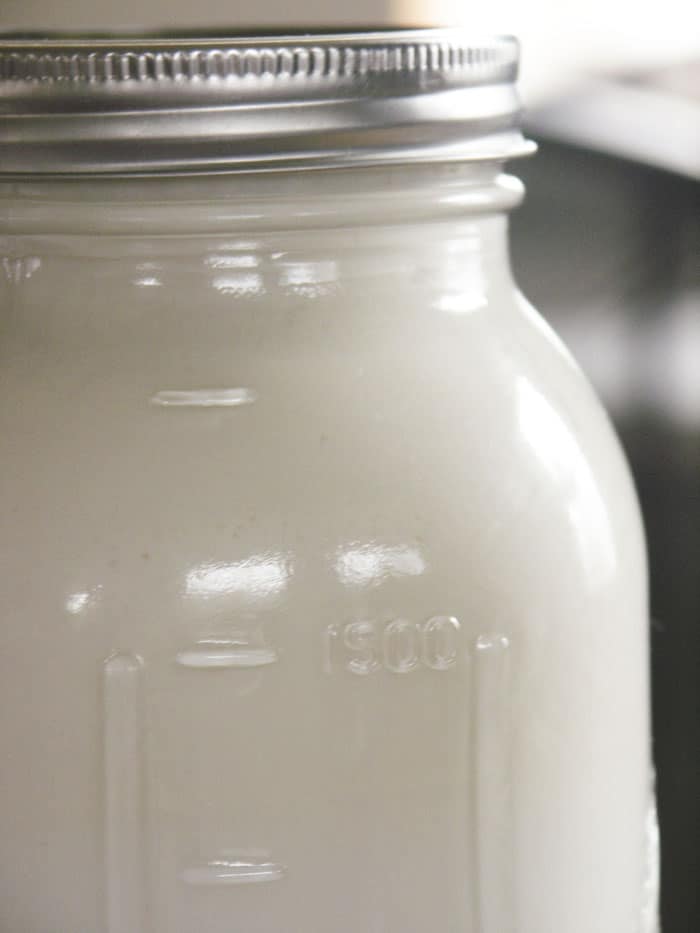
I use a lot of homemade buttermilk. And by ‘a lot’ I mean a ton.
Many of my baked goods contain buttermilk. Much of my salad dressing uses buttermilk.
And my beloved, The Evil Genius? He drinks buttermilk.
Now before any of you out there yawp with a resounding, “EW!” let me just mention that millions of Southerners and displaced Southerners are right now saying, “Mmmmmmmm! A nice tall glass of buttermilk with salt and pepper sounds mighty fine right now.”
A reminder: never yuck another person’s yum. Unless we’re talking durian, then all bets are off… (You may want to read about my family vs. Durian.)
We go through a lot of the stuff. And I may have mentioned that I live in the middle of nowhere in Amish country before (or a million times before, but who’s counting?) so frequent last minute trips to the store are not convenient.
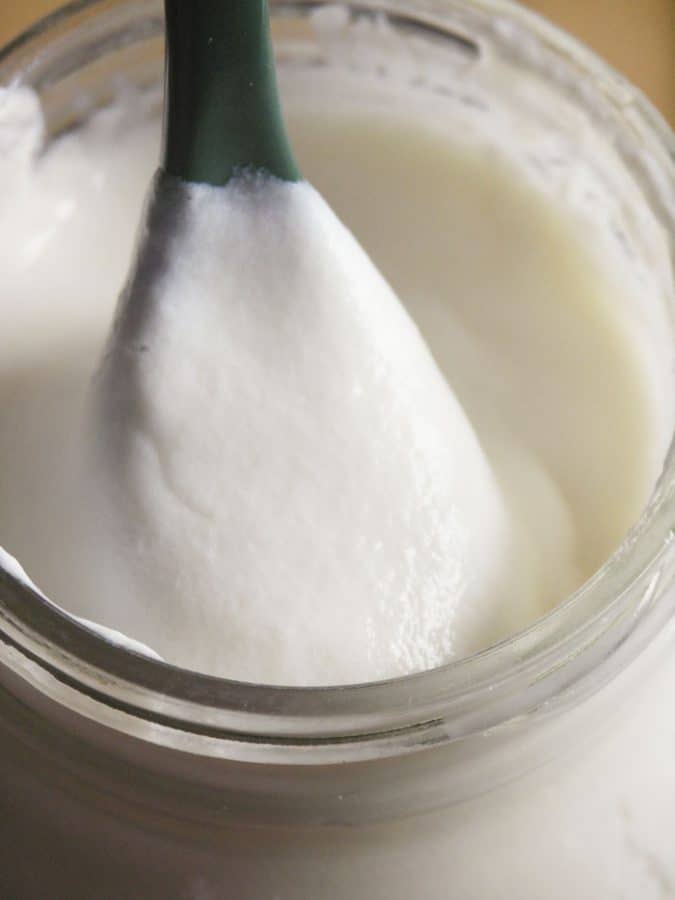
How to Make Real Buttermilk
There are probably quite a few of you out there saying, “Oh please. All you have to do is add a little vinegar or lemon juice to milk and you get the same thing. Why buy buttermilk?”
See? I just knew someone out there was saying it. Not so fast! It’s not the same thing. To prove my point, I have to talk science for a moment.
While the acidified milk might give you the same tang of buttermilk, it lacks woefully in the texture and viscosity department.
Buttermilk is used in recipes for several important reasons. First, it is acidic, so it helps invigorate leavening agents -such as baking powder, baking soda and yeast- when added to baked goods.
The acid also helps combat discoloration in baked goods and promotes deep, beautiful browning. Buttermilk contains natural emulsifiers; this improves texture and aroma, and extends shelf life after baking.
The acidity of your homemade cultured buttermilk makes it a wonderful addition to marinades for chicken and pork. The acid helps tenderize the meat and gives it a tangy flavor.
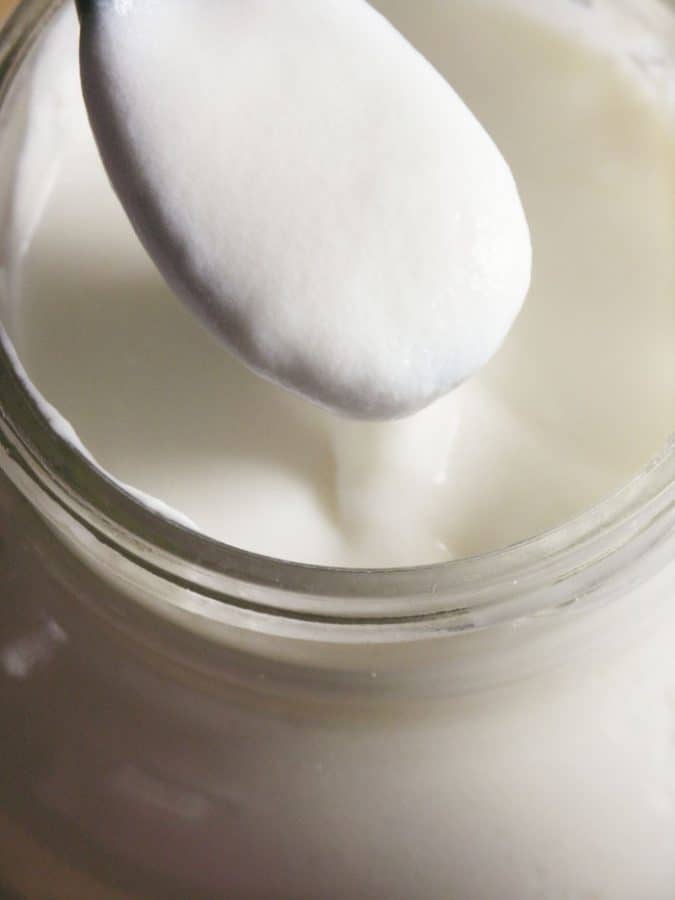
Cultured Buttermilk
You know the ‘cultured’ part of cultured buttermilk? It’s good for you.
It contains many active cultures similar to those found in yogurt. Most of the cultures generally found in buttermilk are form the Lactococcus Lactis family and many of their subspecies.
Those cultures are what make homemade cultured buttermilk so thick and creamy. And what? Good for you!
Now that you know more than you probably ever wanted to know about buttermilk let’s get onto the ‘Why make my own?’ thing. Because you can.
Seriously. You need more than that?
Okay. Also make it because it’s dirt cheap, it’s super simple, it’s really fun and you’ll never run out of buttermilk again.
Hang on one second. Someone out there just said, “I never use a whole thing of buttermilk. What do I do with all that buttermilk?” I’m so glad you asked. How about a few of these ideas:
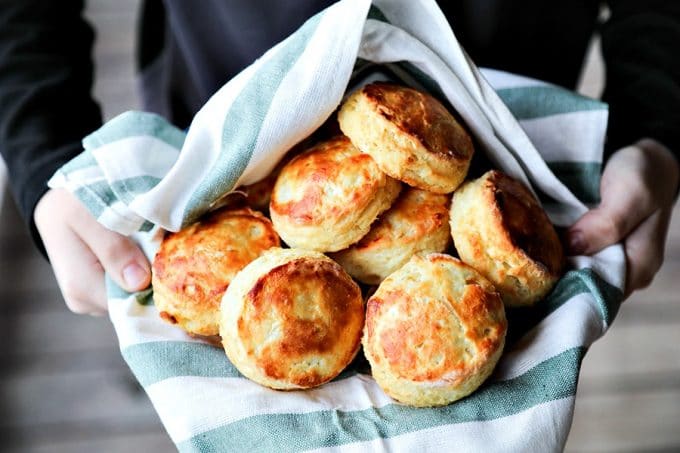
Perfect, flaky, Homemade Buttermilk Biscuit Take it from me, these buttermilk biscuits would do my Arkansas Grandma proud… They’re lofty, flaky, tender, and utterly divine.
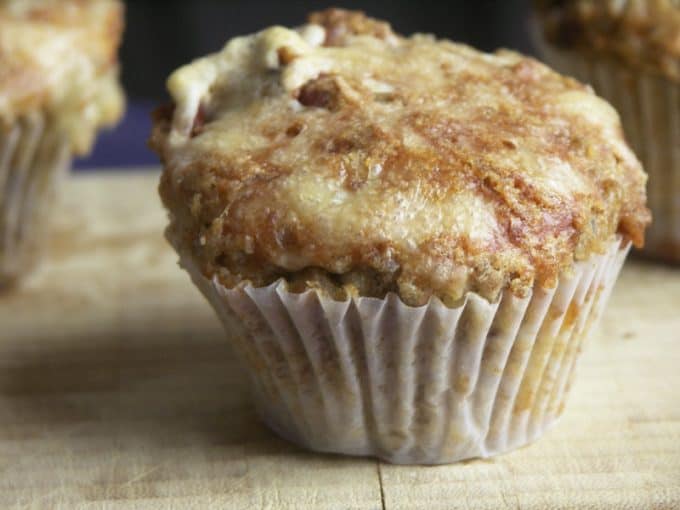
Bacon and Swiss Rye Muffins These are every bit as good as they sound and as easy as pie. No wait! They’re easier than pie. Pie can be hard.
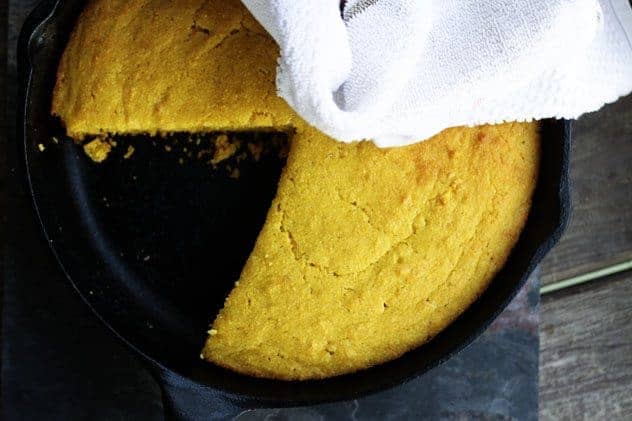
Grandma’s Buttermilk Cornbread This is my Grandma’s buttermilk cornbread recipe and it is ridiculously delicious and the ultimate comfort food.

Buttermilk Cornbread Rounds Based on my Grandma’s Buttermilk Cornbread recipe, these perfectly portioned cornbread rounds fit neatly in the hand and go anywhere cornbread goes, but look cuter doing it! This one’s going a little way back in the FWF archives.
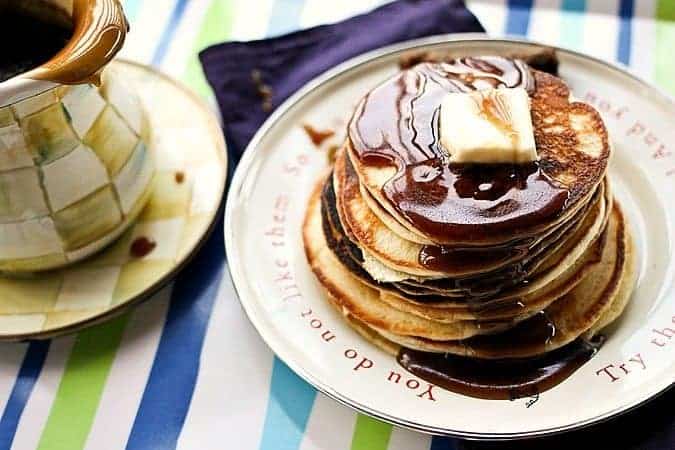
Buttermilk Pancakes Nothing beats beautiful, light, airy buttermilk pancakes smothered in real maple syrup. Nothing. This one’s also reaching way back.

Garam Masala Depression Cake from Val. Nothin’ depressing about THAT cake, I’ll tell you. We’re talking about a decadent, Garam Masala flavored chocolate cake with orange buttercream and toasted coconut.
Oh my. I only take issue with the number of servings Val specified in it. It looks like a one-person cake to me.
I would be remiss if I didn’t mention these others…
- Chocolate Chip Breakfast Cookies (Drop scones)
- Extra Crispy Fried Chicken Fingers (The Evil Genius can cook!)
- Cornbread Salad
Are you good and hungry yet? Excellent. Let’s make some buttermilk. I promise it doesn’t take but two shakes.
Homemade Cultured Buttermilk
Scroll to the bottom for an easy-print version of this recipe!
Ingredients:
- 1/4 to 1/2 cup cultured buttermilk (from the store or home cultured)
- 1 to 2 quarts skim,1%, 2%, or whole milk from the store or raw milk
Also needed:
- 1 clean, dry quart or half gallon jar with a tight fitting two piece lid.
Okay. Ready? If you blink you’ll miss how to do it.
Pour buttermilk (1/4 cup for a quart jar or 1/2 cup for a half gallon jar) into your clean jar. Top off the jar with your plain milk.
Tightly screw lid to the jar and shake vigorously for 1 minute. Place in a warm (but not hot) area out of direct sunlight.
Let it sit there for 12 to 24 hours, until thickened. Refrigerate when thick.
Use within two weeks. If you re-culture this regularly, you can carry on re-culturing indefinitely.
Now here’s a glimpse of my finished product. Note that mine is super thick. I used raw, whole milk to culture my buttermilk. If you use skim, it may end up a little thinner than what you see here.
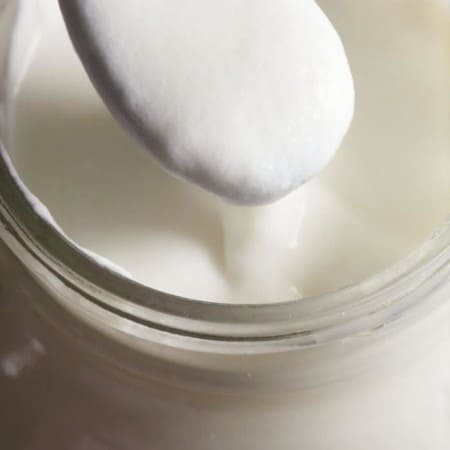
Homemade Cultured Buttermilk
Rate RecipeIngredients
- 1/4 to 1/2 cup cultured buttermilk from the store or home cultured
- 1 to 2 quarts skim 1%, 2%, or whole milk from the store or raw milk
- Also needed:
- 1 clean dry quart or half gallon jar with a tight fitting two piece lid.
Instructions
- Okay. Ready? If you blink you’ll miss how to do it.
- Pour buttermilk (1/4 cup for a quart jar or 1/2 cup for a half gallon jar) into your clean jar. Top off the jar with your plain milk. Tightly screw lid to the jar and shake vigorously for 1 minute. Place in a warm (but not hot) area out of direct sunlight. Let it sit there for 12 to 24 hours, until thickened. Refrigerate when thick. Use within two weeks.
Notes
Nutritional information is an estimate and provided to you as a courtesy. You should calculate the nutritional information with the actual ingredients used in your recipe using your preferred nutrition calculator.
did you make this recipe?
Make sure to tag @foodiewithfam on Instagram and #hashtag it #foodiewithfamily so I can check it out!
This recipe was originally posted March 24, 2010, and was updated with photos, links, and improved notes March 2021.
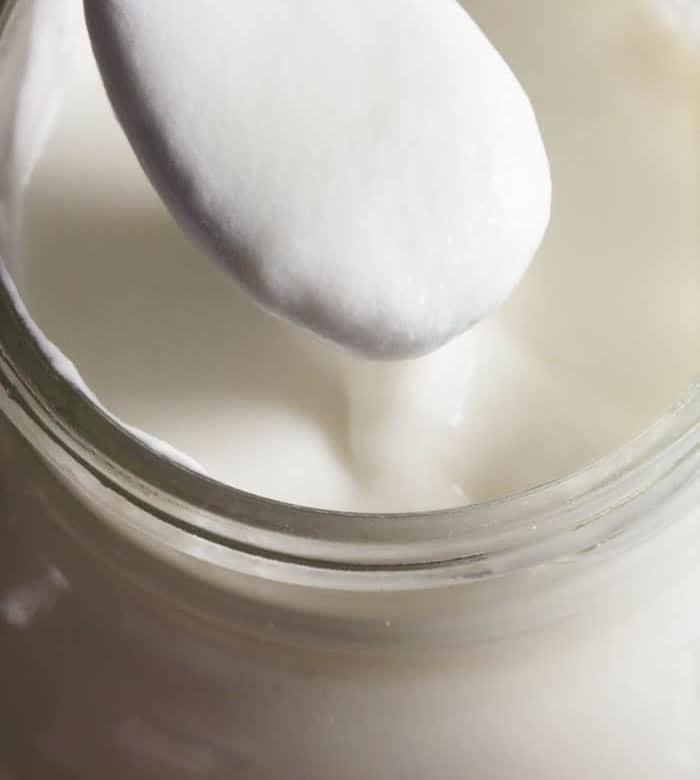



Reader's Thoughts...
Phillip Baucom Sr. says
When I make buttermilk its to thick I can’t pour it or drink it I tried lol what am I doing wrong every gallon is to thick.
I mix 1 cup store bought buttermilk to my gallon of whole milk give it a few shakes take lid off and put Paper towel over it for 24 to 30 hours and it turns out to thick help me please
Rebecca says
Hi Phillip! The homemade stuff made with whole milk is always going to be much thicker! If you’d like it thinner, you can either start with a lower milk fat milk like skim, 1%, or 2% or just thin it out a smidge with fresh milk before drinking it. 🙂 If you give it a good stir or shake, it should loosen up a bit, too!
Joyce says
Sometimes my homemade buttermilk turns out slimy. It’s a really weird consistency like slime. Any idea why? Or tips to get a nice texture?
Rebecca says
Hey Joyce- If you get a fork or small whisk in there and give it a good whirl, it should be a much nicer texture. 🙂
Philip Rock says
It just happened to me, too. A really slimy, gross consistency. The taste was not bad but I can’t drink the stuff with such a mucus-like texture. I used my last batch of buttermilk, which was at least a week old, as the starter. (My original starter came from commercial buttermilk and worked fine.) So this was ‘second generation’ starter (possibly the third, I don’t remember!). I was just reading about a similar thing that can happen with yogurt – and the cause is very often due to wild yeast contamination. I am a microbiologist and just had a look at the microorganisms present in my nasty batch of buttermilk. Sure enough, there is a healthy population of yeast (in addition to the typical lactic acid bacteria). I can’t guarantee that is the reason for the sliminess…but it seems reasonable. Time to go back to a fresh starter.
Hannah says
Thanks so much for posting this recipe! As a southerner I’m addicted to buttermilk in love to drink it for breakfast lunch or dinner.
Mary N says
Thank you! Can’t wait to try this recipe.
Question: I’ve been making homemade yogurt and would rather not buy a quart of buttermilk to start homemade buttermilk, if I can use yogurt as a starter. Can 1/4 cup plain homemade yogurt be Added to the 3 3/4 cups milk to make buttermilk with your recipe? Thank you.
Rebecca says
Hi Mary- Technically they’re different cultures in the buttermilk and yogurt. If you use yogurt, you’ll be making a thinner/cold-culture yogurt that will have a slightly different flavour. 🙂
Donald Readenour says
My grandma used to make the absolute best buttermilk using live cultures from the leftovers from a quart of store-bought buttermilk and mixing it into a gallon of prepared powdered milk that she received in her “commodities” and let set overnight by the hearth. It sometimes would foam over, but when you chilled it, shook it up, and poured it in a glass over crumbled saltine crackers or cornbread, you were in for a TREAT!!!
Rebecca says
That sounds amazing, Donald!
Roger says
I just wanted to say that you should NOT use 2% milk for this. I have always used whole milk and it is really good, but i decided to use 2% milk one day and it was horrible. The buttermilk was like glue and tasted horrible, i also got a stomach shortly after. So i recommend whole milk, but definitely not 2% and possibly lower.
Rebecca says
Thanks for letting us know, Roger!
MaryLou says
Wow, I sure had to go through a lot of recipes that called for vinegar, lemon juice, or cream of tartar before I finally found what I was looking for, whether you could make more buttermilk by adding regular milk to existing buttermilk. I do have a couple questions though. I was wondering if you could use powdered milk to make it. I know, powdered milk, ew. But I have found the Nida brand in a yellow can, made for transitioning babies from formula to milk, to be extremely palatable and worth the extra money at $4.50 per cam. It’s great when I’m traveling to use as coffee creamer instead of that horrible cremora stuff. I also use it to mix up a quick glass of milk to pour over a bowl of cereal. So I was wondering if powdered milk would work to make the buttermilk. I suppose I could experiment but I wondered if you had had any experience with it. Plus the same question only regarding powdered goat milk which I keep on hand because liquid goat milk probably wouldn’t get used up before it spoiled and takes up room in the refrigerator which is at a premium when you travel. Thank you again for the information you provided in this post!
Rebecca says
Hi MaryLou- Thanks so much for your kind review! I have not personally tried making this with powdered milk (and I actually love keeping powdered milk on hand because I live pretty far out from stores!), but theoretically, it shouldn’t be an issue if you’ve reconstituted the milk according to instructions! Please let me know if you give it a go. Ditto on the goat milk. I have a feeling I’d love goat milk buttermilk!! Talk about TANG!
Lynette says
Mine separated , is that normal . It’s thick like ricotta but the liquid is separate
Rebecca says
That’s totally normal! That’s just whey. You can drain that off for a thicker product or stir it back in for a more pourable one. 🙂
Sibyl says
I really like whole fat and 2% buttermilk but really don’t like skim or fat free buttermilk.
Different brands of buttermilk do taste different. If you don’t like one brand, try another. The same with the fst content. Switch until you finally find one you like, which I think you will do.
Rebecca says
I agree, Sibyl! I love whole milk and 2% buttermilk. Thanks for sharing your thoughts!
Roger says
This is a good recipe, but I felt like I could improve it some, so I did. I would do a recipe similar to yours, but I would add 6 cups of whole milk and 1 cup of low fat buttermilk.
I noticed that if you let it sit in a cooler place (70-75 degrees f), then the sour taste is either gone or tolerable.
Also after the 16-20 hours i let it sit (since the cooler temp makes it take longer), i would add 2 or 3 tbsp of vanilla and half a cup of sugar. After all of that my kids would love it and could not get enough of it!
Rebecca says
Thanks for taking the time to rate the recipe, Roger! I’m glad you liked it.
Elizabeth says
Troubleshooting question!
I followed your directions exactly with 1% milk since I had it on hand. After culturing overnight near a baseboard heater (since we live in a basement and it gets decently chilly at night), the jar was very thickened come morning (yay!) so I popped it in the fridge.
When I opened it to use it two days later I noticed the buttermilk was more the consistency and look of yogurt (with whey separated) and a bit jiggly like homemade yogurt.
What can I do to fix it or reculture it or not have this happen again??
Thank you!
Rebecca says
Hi Elizabeth- Just give it a solid shake or stir before using and it’ll be fine! No worries!!
Katie says
Sorry…may sound silly but what do you mean by “reculture it regularly”?
Also can 2% lactose free milk be used instead of 1% 2% or whole milk??
I am assuming this “cultured buttermilk” from the store is in the round carton similar to the size of a crisco container with the red writing on it, correct?
Rebecca says
Hi Katie- At our store, the cultured buttermilk comes in a pint or quart container like a small container of milk. It says “Cultured Buttermilk” on the bottle and is refrigerated. I’ve never used lactose free milk, but I don’t think it would be problem. And when I say reculture regularly, I just mean to use part of your cultured buttermilk as a “starter” for a new batch semi-frequently (weekly or bi-weekly)… xoxoxo
Mary says
Buttermilk when you make it your self do you have to strain it before you use it and just use the liquid i have never use it before
Rebecca says
No need to strain it, Mary! It should be thick-ish like a cross between kefir and yogurt!
smithtimes2 says
I made this last night and it looks great. I can’t wait to make cornbread with this.
Rebecca says
Oh my goodness. That’s going to be some delicious cornbread! Thank you for taking the time to rate the recipe. It is greatly appreciated!
April Gill says
I will try this process. My brothers and I did it the old fashioned wry – we used the churn and dasher. Thereby we had butter and butter milk. Of course our cows supplied the fresh milk!
Rebecca says
Fantastic, April! I hope you enjoy it as much as we do! Fresh butter would be such luxury right now!
Margaret Lee says
No ! When you buy buttermilk—where is the butter? This recipe just makes more of the same.l want buttermilk that doesn’t taste like skim milk
Rebecca says
Hey Margaret! You can make cultured buttermilk with whole milk and WHOA is that luxurious!
Janet says
This is just what I have been looking for, my Mother used to do this but I think she may have used dry milk . Most of the time we had fresh buttermilk from my Grandmother who had a cow. I use a lot of buttermilk and there is no substitute in my opinion. Thank you for posting this.
Rebecca says
You’re so welcome, Janet!! I’m so glad you love it!
Ala al-badran says
Hi Ms. Lindamood
Where to buy Cultured Buttermilk, is it the same as Buttermilk
what is the difference between the Cultured Buttermilk and the yogurt?
Best regards
THANKS
Rebecca says
Hi there, Ala Al-badran. Depending on where you are, it may or may not be the same thing. In the US, most of what is sold as buttermilk is indeed cultured buttermilk. In some European countries, what is sold as buttermilk is the by-product of making butter, and is more of a whey. Both are tangy, but cultured buttermilk is very similar in texture and consistency to kefir, crema, or a thinner, more pourable sour cream. Both buttermilk and yogurt are cultured with good bacteria, but cultured buttermilk (at least in the US) usually has a little note to the effect somewhere on the bottle.
Ala al-badran says
HiMs. Lindamood
Where to buy Homemade Cultured Buttermilk, is it the same as Buttermilk
what is the difference between the Homemade Cultured Buttermilk and the yogurt?
Best regards
THANKS
Pat says
Can you freeze some buttermilk for future use, as to make more buttermilk?
Rebecca says
Hi Pat- Theoretically, that should work quite well. In practice, I almost always have a jar going in the refrigerator and use it up pretty quickly, so I haven’t tried it personally.